How to use pumpkin for medicinal purposes for stomach ulcers?
Due to the peculiarities of the pathology, patients with diseases of the gastrointestinal tract are forced to adhere to a special diet. Medication is only part of therapy. The main thing in the treatment of such diseases is adherence to a special diet. Many foods should not be consumed as they exacerbate the condition.
Let's figure out what the pumpkin is useful for, how and in what quantity you need to eat it, and is it possible to eat pumpkin with stomach ulcers.
The content of the article
Chemical composition
Pumpkin is 91.8% water. It practically does not contain fat (0.1 g per 100 g of product), but it is rich in proteins (1 g) and carbohydrates (4.4 g). Calorie content is 22 kcal raw, 25 kcal - after heat treatment.
The pulp of the fruit also contains other biological active components necessary for the body:
- pectin;
- cellulose;
- enzymes;
- B vitamins;
- vitamin A (retinol);
- vitamin C (ascorbic acid);
- vitamin D (calciferols);
- vitamins of group E, H, K, PP;
- trace elements: zinc, iron, cobalt, copper, fluorine, manganese, iodine;
- macroelements: sulfur, calcium, magnesium, chlorine, potassium, phosphorus, sodium.
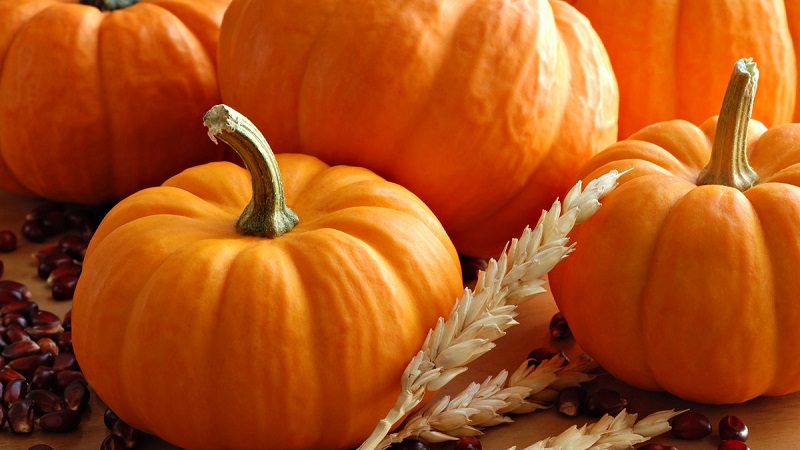
What is the effectiveness of pumpkin for peptic ulcer
Stomach ulcer is a chronic disease. It occurs when the protective components of the gastric mucosa cease to cope with traumatic factors - these include gastric juice and the microbe Helicobacter pylori. Smoking and alcohol increase the risk of developing ulcers. The mucous membrane is injured, causing pain in the epigastric region after eating, nausea, vomiting, heartburn.
Patients are prohibited from taking products that will irritate the mucous membranes due to their physical or chemical properties. The former include, for example, raw vegetables with coarse fiber, nuts and seeds, and dried fruits. The second - acidic foods, as well as those that cause increased secretion of gastric juice.
With its soft texture and neutral pH balance, pumpkin is one of those foods that an irritated stomach digests easily and without pain.
Pumpkin has a beneficial effect on the body:
- soothes irritated mucous membranes;
- accelerates the healing process of ulcerative lesions in the stomach;
- prevents the destruction of living cells by free radicals;
- participates in the formation of new cells;
- removes slags, toxins, chloride salts from the body;
- improves the functioning of the gastrointestinal tract;
- prevents the formation of fatty deposits in the body;
- reduces cholesterol and excess fluid;
- has a laxative effect, facilitates the process of defecation;
- normalizes the motility of the stomach and intestines.
The vegetable is especially useful for bleeding stomach ulcers. The potassium present in the composition stimulates the processes of hematopoiesis, prevents the development of anemia, removes sodium ions, which irritate the gastric mucosa. Minerals and trace elements, in turn, have a beneficial effect on the immune system.

Contraindications for use
The absolute contraindications include the individual intolerance of the vegetable. Carefully prescribe the pulp of the fruit for patients with diabetes mellitus, gastritis with low acidity, duodenal ulcer.
It is recommended to limit or completely exclude the product from the diet in case of a tendency to diarrhea, during an exacerbation of diseases of the gastrointestinal tract.
How to properly use pumpkin for medicinal purposes
Fruit pulp is used as a medicinal raw material and seed... The vegetable is consumed fresh or steamed, boiled, bake, stew. During heat treatment, pumpkin does not lose its beneficial properties, and the amount of vitamins, micro- and macroelements, and other components important for the body remains practically unchanged.
It is not recommended to fry the pulp of the fruit with the addition of butter and fats, as this releases harmful carcinogens and increases the calorie content of the dish.
Important. Some nutritionists advise to use stewed pumpkin: this way it is absorbed faster, easier to digest, without causing heaviness in the stomach.
With gastric ulcer, they begin to consume fruits of 20-30 g per day. Gradually, the daily rate is increased to 150-200 g. The portion can be adjusted, taking into account the severity of the disease. Do not take pulp, seeds and juice - choose one option to make it easier to calculate the dosage of the product.
The course of treatment lasts from 10 days to 2 months. More precise terms are determined by the doctor, taking into account the body's response to the treatment. If necessary, after a break, a second course is prescribed.
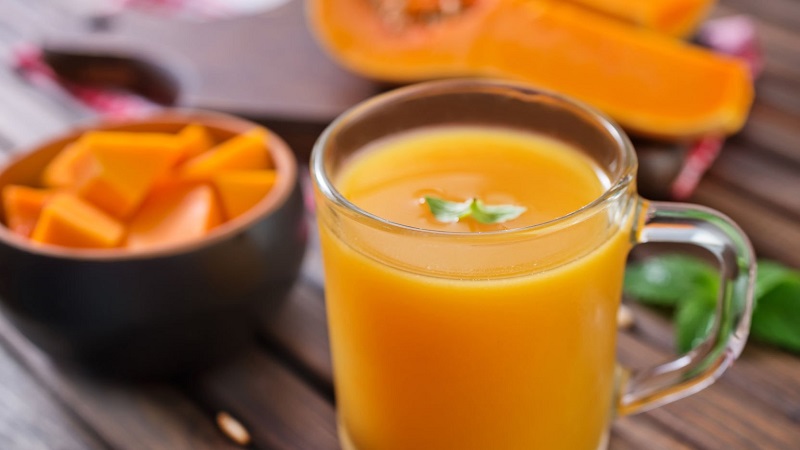
Top 5 recipes
Nutritionists have developed many recipes so that the diet for diseases of the gastrointestinal tract was varied. Consider a few popular recipes.
Pumpkin puree soup
Ingredients:
- pumpkin pulp - 500 g;
- medium carrots - 1 pc.;
- medium onion - 1 pc .;
- olive oil - 2 tablespoons l.
Recipe:
Peel the pumpkin from seeds and peel, cut into small cubes. Put pumpkin, chopped onions and carrots in a saucepan with water or low-fat broth, add olive oil. Simmer under a lid for 30-40 minutes after boiling.
Depending on the type of pumpkin, it may take longer to cook. Beat the cooled soup with a blender until puree. Serve with herbs and crackers, bread.

Pumpkin salad
Ingredients:
- pumpkin - 250 g;
- apple - 2 pcs.;
- kiwi - 1 pc.;
- orange juice - 1 tbsp. l;
- walnuts 70-100 g;
- honey to taste.
Wash vegetables and fruits, peel, cut into small cubes, transfer to a dish. Add chopped walnuts on top. Prepare the orange juice and honey dressing in a separate container. Pour over the salad, stir. If desired, you can add other fruits, raisins, sesame seeds.
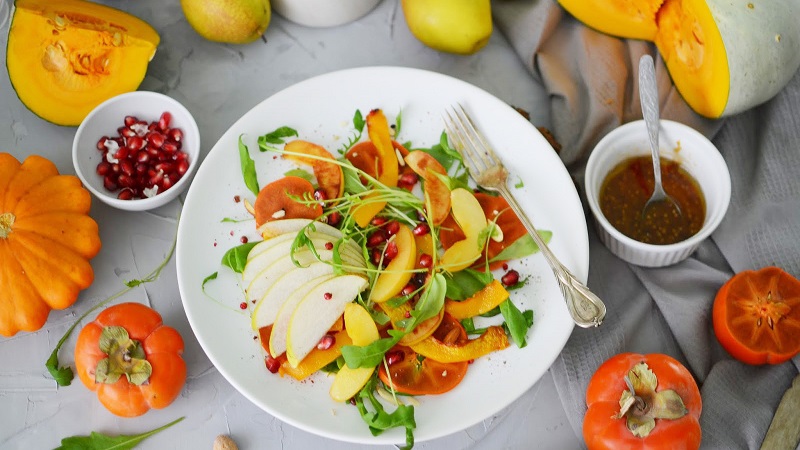
Pumpkin porridge
Pumpkin goes well with oatmeal, millet, brown rice. It is better to eat porridge in the morning - to enrich the body with energy for the whole day. Prepare it in water or skim milk.
Ingredients:
- pumpkin - 500 g;
- water (milk) - 500 ml;
- groats - 1 tbsp.;
- butter - 20 g.
Recipe:
- Remove the peel from the pumpkin, cut into small cubes.
- Rinse the groats several times under running water. Dry.
- Put the pumpkin in a saucepan with water, cover with a lid. 10-15 minutes after boiling water, add cereal, a little sugar and salt. For lovers of soft porridge, before laying cereals, knead the pumpkin pieces with a fork.
- Cook over low heat, covered, until tender. Melt the butter in hot porridge. Add prunes, dried apricots, raisins if desired. Wrap with a towel, leave warm for 15-30 minutes to infuse.
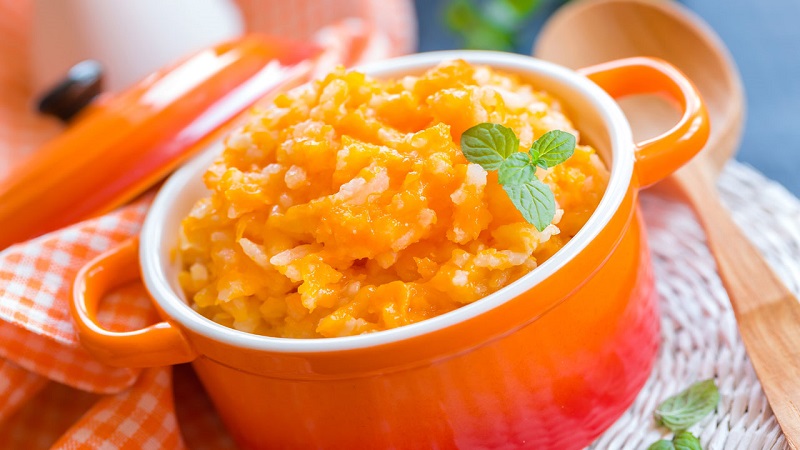
Pumpkin casserole
Ingredients:
- pumpkin - 500 g;
- apples - 200 g;
- semolina - ½ tbsp.;
- eggs - 2 pcs.;
- vanillin;
- sugar - 1 tablespoon;
- soda - ½ tsp;
- butter - 100 g;
- a pinch of salt.
Recipe:
- Peel the vegetable, remove the seeds, cut into small pieces. Put in a metal saucepan, cover with water, cook over medium heat for 15-25 minutes. Willingness to test with a fork.
- Remove the remaining water with a colander, mash the pumpkin with a crush, salt. Leave to cool.
- Grate apples without peel on a coarse grater.
- Beat eggs with sugar in a separate container using a mixer or blender.
- Combine cooled pumpkin, apples, vanillin, butter at room temperature, mix. Gently mix the whipped egg whites into the dough.
- Cover the baking dish with parchment paper, grease with olive oil or butter, lay out the dough.
- Preheat the oven to 200 degrees. Bake the pie for half an hour. It may take more or less time, depending on the oven. Willingness to check with a toothpick.
Transfer the cooled cake to a dish. Serve with sour cream, low-fat cream, honey.
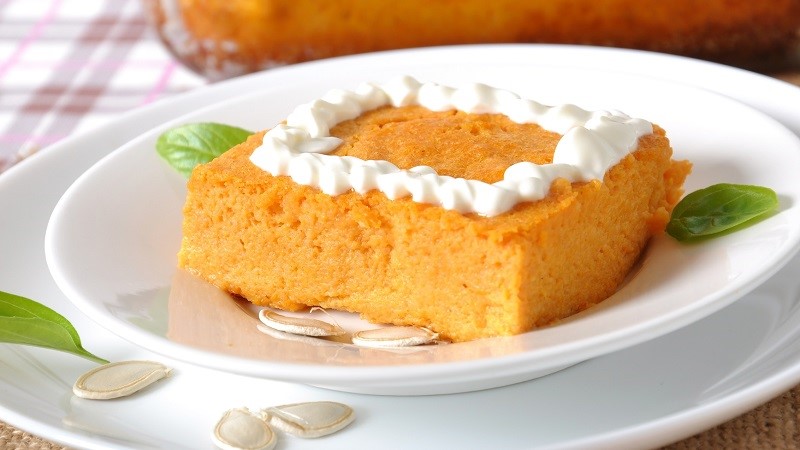
Pumpkin dessert with honey
Ingredients:
- pumpkin pulp - 400 g;
- light sesame - 2 tablespoons;
- honey - 2 tbsp. l .;
- orange juice - 2 tbsp l .;
- refined oil - 1 tbsp. l.
Preparation:
- Cut the pumpkin pulp, peeled from seeds and peel, into oblong pieces.
- Combine honey, oil, orange juice in a dry container. Mix.
- Put the pumpkin slices in the sauce so that they are completely covered with the mixture. Leave under the foil for 5-15 minutes.
- Cover the heat-resistant form with parchment, lay out the pumpkin.
- Bake in a preheated cabinet at medium temperature for 45 minutes. Sprinkle hot slices with sesame seeds.

Conclusion
Regular consumption of pumpkin can improve overall health, reduce the severity of symptoms of stomach ulcer, and accelerate recovery. Despite all the positive properties, pumpkin can cause complications and aggravate the course of concomitant diseases.
In order to prevent this, it is important to first discuss the advisability of using pumpkin with a gastroenterologist, to identify and exclude possible contraindications.